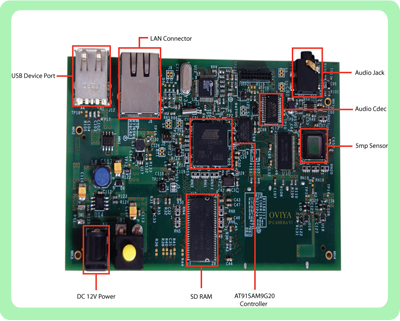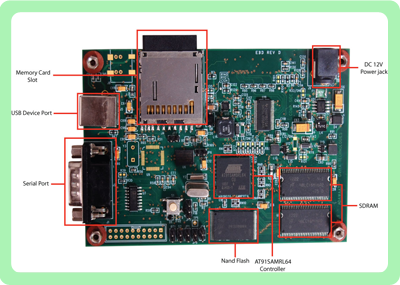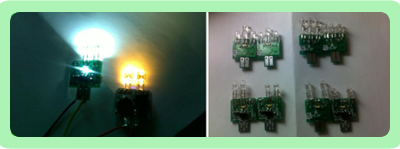Development Kits
1. Development Kit-AT91sam9g20
Development Board Features
Processor Sub system
AT91SAM9G20, ARM926EJ-S™ ARM® Thumb® Processor, 400MHz 32-KByte Data Cache, 32-KByte Instruction Cache, Write Buffer
Memory Interface
64MB SDRAM Volatile memory, 32MB NAND Flash memory
Video
MT9001 Micron Camera Sensor, 640x480, 720P image format support, Dual camera connected. Maximum pixel size 5MB.
Imaging
Bayer pattern format, RGB format, JPEG compress format
OS Support
Linux 2.6.30 kernel, UBoot, Ramdisk files system.
GPRS & Protocol
Airtel/Vodafone/BSNL gprs support, Image Transfe via FTP protocol.
USB
2xFull size USB 2.0, USB OTG
Storage
1x SD Card
Networking
Ethernet through RJ45 connector
Debug
Serial RS-232, 1xUser LED.
Power
DC 12V

2. AT91SAM9RL64 Development Board
Development Board Features<
Processor Sub system
AT91SAM9R64/RL64, ARM926EJ-S™ ARM® Thumb® Processor, 400MHz, 32KB ROM, 64KB FAST SRAM.
Memory Interface
32MB SDRAM Volatile memory, 512MB NAND Flash memory.
Display
10.2 inch display panel with WVGA(852x480) pixel support, ITU-R BT.601/ITU-R BT.656.
Audio
Stereo Audio Input and Output Jacks
OS Support
Linux 2.6.24 kernel, UBoot, Ramdisk files system, QT application.
USB
2xFull size USB 2.0, USB OTG
Storage
1x SD Card
Networking
Ethernet through RJ45 connector
Miscellaneous
1xUser LED, 4xKEY INPUT.
Debug
Serial RS-232.
Power
DC 12V

3. IMX53 Development Board
IMX53 Devkit is is a fully-featured evaluation platform for the Free scale IMX53-based microcontroller. IMX53 comprised Video processing unit, 3D graphics unit, Image processing unit
The evaluation kit allows users to extensively evaluate, prototype and create application specific designs.
Development Board Features
Processor Sub system
IMX53 Freescale, ARM926EJ-S™ ARMRCortex™-A8 core,1.2HHz, DDR2-800, LVDDR2-800 and DDR3-800 DRAM.
Hard disk Interface
SATA-2 Interface, 1.5Gpbs
Memory Interface
128MB DDR-2 Volatile memory, 512MB NAND Flash memory.
Display
LVDS serial ports, TV-out/VGA port, LCD display interface.
Camera Sensor Interface
2x Camera port Interface.
Audio
Stereo Audio Input and Output Jacks, I2C, AC97 audio interface support.
OS Support
Linux 2.6.38 kernel, UBoot, Ramdisk files system, Android OS support.
USB
2xFull size USB 2.0, USB OTG.
Storage
1x MMX/SD Card Interface support
Networking
Ethernet through RJ45 connector
Miscellaneous
1xUser LED, 4xKEY INPUT, 2x I2C Interface, Ethernet controller Interface.
Debug
Serial RS-232.
Power
DC 12V

4. LPC1751 Motor Control Board
The LPC1751 Motor Control Board is a full-featured evaluation board based on the NXP processor LPC1751 which runs at up to 12mm, 512 flash Memories In this Processor to control the two DC series motor. In both forward and reverse direction and speed is controlled by using PWM Up to 80% speed is available in this DC motors.
In stepper motor also rotate in clockwise and anticlockwise both the direction. Stepper motor speed controlled by step by step by this LPC 1751 processor.
Key Features:
- 32-Bit ARM Cortex-M3 Microcontroller and can operate at CPU frequencies up to 100MHz
- For RAW power input, JACK connector and Wire to Connector provisions are provided.
- The Board can be powered from BaseBoard.
- It supports FLASH MAGIC for Programming the Flash by using external UART to USB converter FT232R.
- Small Form factor.
- Fine Pitch standard board to board connector from SAMTEC for Expansion support.
- Standard JTAG connector for debug & development based on LPCEXPRESSO or any other related IDE.
- It will generate the PWN and control the DC series Motor.
 images/at91sam9g20-kit.png
images/at91sam9g20-kit.png
5. Led display Bar - visibility LPC 1313
Seven Segment LED equipped product available for display the custom message. LPC71113 controller based product is connected with 10 LED display unit. Message updated to Controller via RF communication. Each LED unit has capable of 6 messages display over it. 10 LED display unit can configure/control via RF communication protocol. LPC71113 microcontroller has built in feature of CAN interface and SPI interface for message communication.
Key Features:
- The LPC1114/LPC1114 are a ARM Cortex-M0 based, low-cost 32-bit MCU family, designed for 8/16-bit microcontroller applications
- The LPC111x operate at CPU frequencies of up to 50 MHz.
- In-System Programming (ISP) and In-Application Programming (IAP) via on-chip bootloader software.
- SPI controllers with SSP features and with FIFO with multi-protocol capabilities .
- 32 kB of flash Memory.
- 8 kB of data memory(SRAM).
- One 10-bit ADC.
- 4 x general purpose timers.
- C-Based, Software Driver is available ready to check the features.
- RJ11 Connector for software programming .
- Serial Debug interface.

6. LPC1768 Development Board
The LPC1768 Development Board is a full-featured evaluation board based on the NXP processor LPC1768 which runs at up to 12MHz, with 512 Kbytes Flash memories. The LPC1768 Development board provides a wide range of peripherals, includes a CAN interface with RJ45 connector, MMC interface, Ethernet 10/100 interface, Mini USB port, KEY-PAD, User LED , USB host/device port.
In addition, software for the board and example program for each peripheral is readily available. This enables designers to quickly begin NXP code development and test new designs. LPCXpresso Integrated Development Environment (IDE) for code development.
Key Features:
- 32-Bit ARM Cortex-M3 Microcontroller and can operate at CPU frequencies up to 100MHz
- For RAW power input, JACK connector and Wire to Connector provisions are provided.
- The Board can be powered either from Power Input or Any USB device port by connecting to Host.
- It supports FLASH MAGIC for Programming the Flash by using on board UART to USB converter FT232R .
- On Board DC-DC converter for generating 5V/3A and 3.3V/1.5A from Power Input of 8V to 18V.
- USB Host / USB Device / USB OTG – three USB ports are provided and port shall be selected by DIP switch.
- 10/100Mbps interface provided with RJ-45 Connector.
- CAN connector as RJ-45 is provided with CAN 2.0 Specifications.
- On Board MMC connector for storage memory with high speed SPI interface.
- Small Form factor.
- Fine Pitch standard board to board connector from SAMTEC for Expansion support.
- Standard JTAG connector for debug & development based on LPCEXPRESSO or any other related IDE.
- There are 2 LEDs for general purpose use.
- There are 3 Keys for general purpose use.
- External headers for SPI, UART, I2C.

7. LPC1788 Development Board
The LPC1788 Development Board is a full-featured evaluation board based on the NXP processor LPC1788 (ARM CORTEX-M3) which runs at up to 12MHz, with 512 Kbytes Flash memories. The board provides a wide range of peripherals, includes a CAN interface with RJ45 connector, MMC interface, Ethernet 10/100 interface, NAND Flash memory, SDRAM memory, Mini USB port, KEY-PAD, User LED , USB host/device port.
In addition, software for the board and example program for each peripheral is readily available. This enables designers to quickly begin NXP code development and test new designs. LPCXpresso Integrated Development Environment (IDE) for code development.
Key Features:
LPC1788 – Development Board
- 32-Bit ARM Cortex-M3 Microcontroller and can operate at CPU frequencies up to 120MHz with 512KB internal Flash and 96KB internal SRAM
- On Board SDRAM memory of 64MB with 32-bit Data interface.
- On board NAND Flash memory of 512MB with 8-Bit Data interface.
- It supports FLASH MAGIC for Programming the Flash by using on board UART to USB converter FT232R .
- On Board DC-DC converter for generating 5V/3A and 3.3V/1.5A from Power Input of 8V to 18V.
- For RAW power input, JACK connector and Wire to Connector provisions are provided.
- The Board can be powered either from Power Input or Any USB device port by connecting to Host.
- USB Host / USB Device / USB OTG – three USB ports are provided and port shall be selected by DIP switch.
- 10/100Mbps interface provided with RJ-45 Connector
- CAN connector as RJ-45 is provided with CAN 2.0 Specifications
- On Board MMC connector for storage memory using SD/MMC interface
- Small Form factor
- Fine Pitch standard board to board connector from SAMTEC for Expansion support
- Standard JTAG connector for debug & development based on LPCEXPRESSO or any other related IDE.
- There are 2 LEDs for general purpose use
- There are 3 Keys for general purpose use
- External headers for SPI, UART, I2C, I2S
- 24-bit LCD FPC connector interface is provided for Display Expansion

8.ATMEGA2560 Development Board
The ATMEGA2560 Development Board is a full-featured evaluation board based on the ATMEL processor ATMEGA2560 which runs at up to 12MHz, with 256 Kbytes Flash memories. The board provides a wide range of peripherals, includes a Serial interface with RS232 connector, MMC interface, KEY-PAD, User LED.
In addition, software for the board and example program for each peripheral is readily available. This enables designers to quickly begin ATMEGA code development and test new designs. AVR Studio Integrated Development Environment (IDE) for code development. The ATMEGA2560 Development Kit contains all of the hardware and software required for evaluating and developing with ATMEG series microcontrollers.
Key Features:
- High performance 8-Bit AVR Microcontroller and can operate at CPU frequencies up to 16MHz with 128KB internal Flash and 4KB
internal SRAM. - It supports on board UART to USB converter FT232R .
- On Board DC-DC converter for generating 5V/3A and 3.3V/1.5A from Power Input of 8V to 18V.
- For RAW power input, JACK connector and Wire to Connector provisions are provided.
- The Board can be powered either from Power Input or USB device port [UART to USB converter] by connecting to Host.
- On Board MMC connector for storage memory with SPI interface.
- Small Form factor.
- Fine Pitch standard board to board connector from SAMTEC for Expansion support.
- Standard JTAG connector for debug & development
- Serial ISP connector interface
- There are 2 LEDs for general purpose use
- There are 3 Keys for general purpose use
- CAN Interface with RJ-45 ConnectorExternal headers for UART, ADC

9. AT90CAN128 Development Board
The AT90CAN128 Development Board is a full-featured evaluation board based on the ATMEL processor AT90CAN128 which runs at up to 12MHz, with 128 Kbytes Flash memories. The board provides a wide range of peripherals, includes a CAN interface with RJ45 connector, UART interface, MMC interface, KEY-PAD, User LED.
In addition, software for the board and example program for each peripheral is readily available. This enables designers to quickly begin ATMEL controller code development and test new designs. AVR Studio Integrated Development Environment (IDE) for code development.
The AT90CAN128 Development Kit contains all of the hardware and software required for evaluating and developing with ATMEL CAN microcontrollers.
Key Features:
- Advanced 8-Bit AVR Microcontroller and can operate at CPU frequencies up to 16MHz with 256KB internal Flash and 8KB internal SRAM.
- It supports on board UART to USB converter FT232R .
- On Board DC-DC converter for generating 5V/3A and 3.3V/1.5A from Power Input of 8V to 18V.
- For RAW power input, JACK connector and Wire to Connector provisions are provided.
- The Board can be powered either from Power Input or USB device port [UART to USB converter] by connecting to Host.
- On Board MMC connector for storage memory with SPI interface.
- Small Form factor.
- Fine Pitch standard board to board connector from SAMTEC for Expansion support.
- Standard JTAG connector for debug & development
- Serial ISP connector interface
- There are 2 LEDs for general purpose use
- There are 3 Keys for general purpose use






